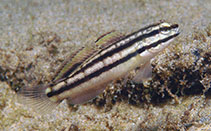| Family: |
Gobiidae (Gobies), subfamily: Gobiinae |
| Max. size: |
6.5 cm TL (male/unsexed) |
| Environment: |
reef-associated; marine; depth range 1 - 10 m |
| Distribution: |
Western Central Pacific: Iriomotejima and the Philippines; also from West New Guinea. |
| Diagnosis: |
Dorsal spines (total): 6-7; Dorsal soft rays (total): 13-13; Anal spines: 1-1; Anal soft rays: 12-12. Characterized by generally whitish body color with three black stripes on upper two-thirds of head and body; presence of diffuse narrow bars on side; first and second dorsal fin equal in height; rounded caudal fin; longitudinal scale series 60; fully scaled predorsal region; scales dorsally on opercle, absent on cheek; ctenoid body scales; cycloid scales on nape, abdomen, and opercle; depth of body 4.5-4.8 in SL (Ref. 90102). |
| Biology: |
Occurs on silty mud flats among the aerial roots of mangroves (Ref. 37816). Also found in stream mouths or occasionally in saline lakes in 0-3 m (Ref. 90102). Max. length (Edward O. Murdy, pers. comm., 1998). |
| IUCN Red List Status: |
Least Concern (LC); Date assessed: 27 August 2020 Ref. (130435)
|
| Threat to humans: |
harmless |
Source and more info: www.fishbase.org. For personal, classroom, and other internal use only. Not for publication.
